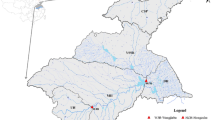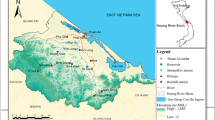Abstract
A statistical model has been developed to forecast domestic water demand by considering climate change, population growth, urbanization, lifestyle changes and technological advances. The developed model is used to forecast future domestic water demand in different sub-basins of Huaihe River Basin of China. The study reveals that mean temperature in Huaihe River Basin will increase by 0.7–1.6 °C, population will reach to 230 million, and 61.2% of the basin area will be urbanized by the year 2030, which will cause a sharp increase in domestic water demand. The increase in domestic water demand for 1 °C increase in mean temperature is found to vary between 0.549 × 108 and 5.759 × 108 m3 for different sub-basins of Huaihe River. The forecasted change in domestic water demand is also found to vary widely for different general circulation models (GCMs) used. The GCM BCC-CSM1-1 projected the highest increase in domestic water demand, 168.44 × 108 m3 in 2020, and the GISS-E2-R the lowest, 119.21 × 108 m3. On the other hand, the BNU-ESM projected the highest increase, 196.03 × 108 m3, and the CNRM-CM5 the lowest, 161.05 × 108 m3 in year 2030. Among the different sub-basins, the highest increase in water demand is projected in Middlestream of Huaihe River in the range of 46.9 × 108–65.5 × 108 m3 in 2020, and 61.3 × 108–76.1 × 108 m3 in 2030, which is supposed to cause serious water shortage and an increase in competition among water-using sectors.










Similar content being viewed by others
References
Adamowski, J. F. (2008). Peak Daily Water Demand Forecast Modeling Using Artificial Neural Networks. Journal of Water Resources Planning and Management, 134(2), 119–128.
Aidam, P. W. (2015). The impact of water-pricing policy on the demand for water resources by farmers in Ghana. Agricultural Water Management, 158(C), 10–16.
Altukaynak, A. S., Özger, M., & Çakmakci, M. (2005). Water consumption Prediction of Istanbul city by using Fuzzy logic approach. Water Resources Management, 19, 641–654.
Alvisi, S., Franchini, M., & Marinelli, A. (2003). A Stochastic Model for Representing Drinking Water Demand at Residential Level. Water Resources Management, 17, 197–222.
Al-Zahrani, M.A., & Abo-Monasar, A. (2015). Urban Residential Water Demand Prediction Based on Artificial Neural Networks and Time Series Models. Water Resources Management
Amarasinghe, U. A.; Smakhtin, V. (2014). Global water demand projections: past, present and future. Colombo, Sri Lanka: International Water Management Institute (IWMI). 32p. (IWMI Research Report 156). doi: 10.5337/2014.212.
Babel, M. S., Bhusal, S. P., & Wahid, S. M. (2014a). Climate change and water resources in the Bagmati River Basin. Nepal. Theor Appl Climatol, 115, 639–654.
Babel, M. S., Das Gupta, A., & Pradhan, P. (2007). A multivariate econometric approach for domestic water demand modeling: An application to Kathmandu. Nepal. Water Resources Management, 21, 573–589.
Babel, M. S., Maporn, N., & Shinde, V. R. (2014b). Incorporating Future Climatic and Socioeconomic Variables in Water Demand Forecasting: A Case Study in Bangkok. Water Resources Management, 28, 2049–2062.
Balling, R. C., Jr., & Gober, P. (2007). Climate Variability and Residential Water Use in the City of Phoenix, Arizona. Journal of Applied Meteorology and Climatology, 46, 1130–1137.
Bougadis, J., Adamowski, K., & Diduch, R. (2005). Short-term municipal water demand forecasting. Hydrological Process, 19(1), 137–148.
Breyer, E. Y. (2014). Household Water Demand and Land Use Context: A Multilevel Approach. Master of Science: Portland State University.
Browne, A. L., Medd, W., & Anderson, B. (2013). Developing Novel Approaches to Tracking Domestic Water Demand Under Uncertainty—A Reflection on the “Up Scaling” of Social Science Approaches in the United Kingdom. Water Resources Management, 27, 1013–1035.
Butler, D., & Memon, F. A. (2006). Water Demand Management. London: IWA Publishing.
Caiado, J. (2010). Performance of Combined Double Seasonal Univariate Time Series Models for Forecasting Water Demand. Journal of Hydrology Engineering, 15(3), 215–222.
Chang, H., Praskeivicz, S., & Parandvash, H. (2014). Sensitivity of Urban Water Consumption to Weather and Climate Variability at Multiple Temporal Scales: The Case of Portland, Oregon. International Journal of Geospatial and Environmental Research, 1(1), 1–19.
Combalicer, E. A., Cruz, R. V. O., Lee, S., & Im, S. (2010). Assessing climate change impacts on water balance in the Mount Makiling forest. Philippines. J Earth Syst Sci, 119(3), 265–283.
Corbella, H. M., & Sauri Pujol, D. (2009). What lies behind domestic water use? A review essay on the drivers of domestic water consumption. Bol. Asoc. Geogr. Esp., 50, 297–314.
Deng, X., Guneralp, B., Zhan, J., & Su, H. (2014). Land use impacts on climate. London: Springer.
Downing, T. E., & Butterfield, R. E. (2003). Edmonds B (2003) Climate Change and the Demand for Water. Stockholm Environment Institute Oxford Office, Oxford: Research Report.
Dursun S (2010). Effect of Global Climate Change on Water Balance of Beyşehir Lake (Konya – Turkey). BALWOIS 2010, Ohrid, Republic of Macedonia, 25-29 May 2010.
EPD (2007). Method for determining future water demand needs for public/private water systems. Georgia Environmental Protection Division (EPD) guidance document.
Fagiani, M., Squartini, S., Gabrielli, L., Spinsante, S., & Piazza, F. (2015). Domestic water and natural gas demand forecasting by using heterogeneous data: A preliminary study. Smart Innovation, Systems and Technologies, 37, 185–194.
Fan, L., Liu, G., Wang, F., Geissen, V., & Ritsema, C. J. (2013). Factors Affecting Domestic Water Consumption in Rural Households upon Access to Improved Water Supply: Insights from the Wei River Basin. China. PLoS ONE, 8(8), e71977. doi:10.1371/journal.pone.0071977.
FAO (Food and Agriculture Organization of the United Nations). 2012a. AQUASTAT database. Available at www.fao.org/nr/water/aquastat/data (accessed on March 22, 2014).
Ghiassi, M., Zimbra, D. K., & Saidane, H. (2008). Urban Water Demand Forecasting with a Dynamic Artificial Neural Network Model. Journal of Water Resources Planning and Management, 134(4), 138–146.
Giordano, M., Zhu, Z., Cai, X., Hong, S., Zhang, X., & Xue, Y. (2004). Water Management in the Yellow River Basin: Background, Current Critical Issues. Comprehensive Assessment Research Report 3. Colombo, Sri Lanka: International Water Management Institute.
House-Peters, L. A., & Chang, H. (2011). Urban water demand modeling: Review of concepts, methods, and organizing principles. Water Resources Research, 47, W05401. doi:10.1029/2010WR009624.
Howe, C., Jones, R. N., & Maheepala, S. (2005). Implications of Potential Climate Change for Melbourne’s Water Resources. Melbourne: CSIRO Urban Water, CSIRO Atmospheric Research.
HRC (1998-2012). Huaihe river water resources bulletin for year 2009. Huaihe River Commission, Chinese Ministry Water Resources (in Chinese).
Hunt, D. V. L., & Rogers, C. D. F. (2014). A Benchmarking System for Domestic Water Use. Sustainability, 6, 2993–3018.
IPCC (2007). Summary for policymakers. In: Climate Change 2007: The physical science basis. Contribution of working group I to the fourth assessment report of the intergovernmental panel on climate change. Solomon S, Qin D, Manning M, Chen Z, Marquis M, Averyt KB, Tignor M Miller HL (eds) Cambridge University Press, Cambridge, United Kingdom and New York, NY, USA.
IWMI (2000). World water supply and demand. 1995–2025. Draft report, 88p, International Water Management Institute.
Jakimavičius, D., & Kriaučiūnienė, J. (2013). The climate change impact on the water balance of the Curonian Lagoon. Water Resources, 40(2), 120–132.
Karamouz M, Yazdi MSS, Ahmadi B, Zahraie B (2011). A system dynamics approach to economic assessment of water supply and demand strategies. Paper presented at the World Environmental and Water Resources Congress 2011: Bearing Knowledge for Sustainability - Proceedings of the 2011 World Environmental and Water Resources Congress 1194–1203.
Khatri KB, Vairavamoorthy K (2009). Water Demand Forecasting for the City of the Future against the Uncertainties and the Global Change Pressures: Case of Birmingham. World Environmental and Water Resources Congress 2009: Great Rivers.
Kim, Soojun, Kim, Byung Sik, & Jun, Hwandon. (2014). Assessment of future water resources and water scarcity considering the factors of climate change and social–environmental change in Han River basin. Korea Stoch Environ Res Risk Assess. doi:10.1007/s00477-014-0924-1.
Matos, C., Pereira, S., Amorim, E. V., Bentes, I., & Briga-Sa, A. (2014). Wastewater and greywater reuse on irrigation in centralized and decentralized systems - an integrated approach on water quality, energy consumption and CO2 emissions. Science of the Total Environment, 493, 463–471. doi:10.1016/j.scitotenv.2014.05.129.
MWR (2000-2012). China Water Resources Bulletin. Ministry of Water Resources (MWR), Beijing.
OECD (2012). The OECD Environmental Outlook to 2050: The Consequences of Inaction. OECD and the PBL Netherlands Environmental Assessment Agency. The Outlook includes chapters on: socioeconomic developments, climate change, biodiversity, water, and health and environment.
Pohle, P., Park, M., & Hefter, T. (2012). Livelihood analysis of small-scale farming households in southern Ecuador. Tropical Mountain Forest Newsletter 16. DFG Research Unit, 816, 10–11.
Protopapas AL, Katchamart S, Platonova A (2000). Weather effects on daily water use in New York City. Journal of Hydrologic Engineering 332–338.
Romano, G., Salvati, N., & Guerrini, A. (2014). Estimating the Determinants of Residential Water Demand in Italy. Water, 6, 2929–2945.
Shahid S, Alamgir M, Hazarika MK, Nashrullah S, bin Harun S, Shamsudin S (2015). Analysis of meteorological drought pattern during different climatic and cropping seasons in Bangladesh. JAWRA Journal of the American Resources Association.
Shalizi Z (2008). CHAPTER 7: Water and Urbanization. pp 157-179. In: China Urbanizes: Consequences, Strategies, and Policies (Yusuf S and Saich T eds.). The International Bank for Reconstruction and Development/The World Bank: New York
Suyu L (2010). Establishment of Water-saving Systems of Huai River Basin in China. Proceedings of International Conference on Mechanic Automation and Control Engineering (MACE), 26-28 June 2010, WUhan, pp 2113 - 2116. doi: 10.1109/MACE.2010.5536163.
Vörösmarty CJ, Green P, Salisbury J, Lammers RB (2000). Global Water Resources: Vulnerability from Climate Change and Population Growth, Science, 289, 14 July, pp. 284-288.
Wada, Y., Wisser, D., Eisner, S., Flörke, M., Gerten, D., Haddeland, I., et al. (2013). Multimodel projections and uncertainties of irrigation water demand under climate change. Geophysical Reseach Letters, 40(17), 4626–4632.
Wang, X.-J., Zhang, J.-Y., Amgad, E., Sondoss, E., & Shang, M. (2011). A strategy to deal with water crisis under climate change for mainstream in the middle reaches of Yellow River. Mitigation and Adaptation Strategies for Global Change, 16(5), 555–566.
Wang, X.-J., Zhang, J.-Y., Shahid, S., Amgad, E., & He, R.-M. (2012). Water resources management strategy for adaptation to droughts in China. Mitigation and Adaptation Strategies for Global Change, 17(8), 923–937.
Wang, X.-J., Zhang, J.-Y., Shahid, S., Oyang, R.-L., Guan, T.-S., Xue, J.-G., et al. (2016). Impacts of climate variability and changes on domestic water use in the Yellow River Basin of China. Mitigation and Adaptation Strategies for Global Change. doi:10.1007/s11027-015-9689-1.
Wang, X.-J., Zhang, J.-Y., Shahid, S., et al. (2013). Historic water consumptions and future management strategies for Haihe River basin of Northern China. Mitigation and Adaptation Strategies for Global Change. doi:10.1007/s11027-013-9496-5.
Wang, X.-J., Zhang, J.-Y., Shahid, S., et al. (2014a). Adaptation to climate change impacts on water demand. Mitigation and Adaptation Strategies for Global Change. doi:10.1007/s11027-014-9571-6.
Wang, X.-J., Zhang, J.-Y., et al. (2014b). Impact of climate change on regional irrigation water demand in Baojixia irrigation district of China. Mitigation and Adaptation Strategies for Global Change. doi:10.1007/s11027-014-9594-z.
WRG (2030) The 2030 Water Resources Group. Charting Our Water Future: Economic frameworks to inform decision-making. file:///C:/Users/User/Downloads/Charting_Our_Water_Future_Full_Report_pdf.
Zhang, H. (2005). Strategic Study for Water Management in China. Nanjing, China: Southeast University Press.
Zhou, S. L., McMahona, T. A., Waltonb, A., & Lewisb, J. (2000). Forecasting daily urban water demand: a case study of Melbourne. Journal of Hydrology, 236, 153–164.
Acknowledgements
We are grateful to the National Natural Science Foundation of China (No. 51309155, 41330854), National Basic Research Program of China (No. 2010CB951104 and 2010CB951103), Strategic Consulting Projects of Chinese Academy of Engineering (NO:2016-ZD-08-05-02), Open Research Fund of State Key Laboratory of Simulation and Regulation of Water Cycle in River Basin China Institute of Water Resources and Hydropower Research (NO:IWHR-SKL-201515) and the Asia-Pacific Network for Global Change (Grant No. ARCP2013-25NSY-Shahid) for providing financial support for this research. We are also thankful to anonymous reviewers and editors for their helpful comments and suggestions.
Author information
Authors and Affiliations
Corresponding author
Rights and permissions
About this article
Cite this article
Wang, XJ., Zhang, JY., Shahid, S. et al. Modeling domestic water demand in Huaihe River Basin of China under climate change and population dynamics. Environ Dev Sustain 20, 911–924 (2018). https://doi.org/10.1007/s10668-017-9919-7
Received:
Accepted:
Published:
Issue Date:
DOI: https://doi.org/10.1007/s10668-017-9919-7




